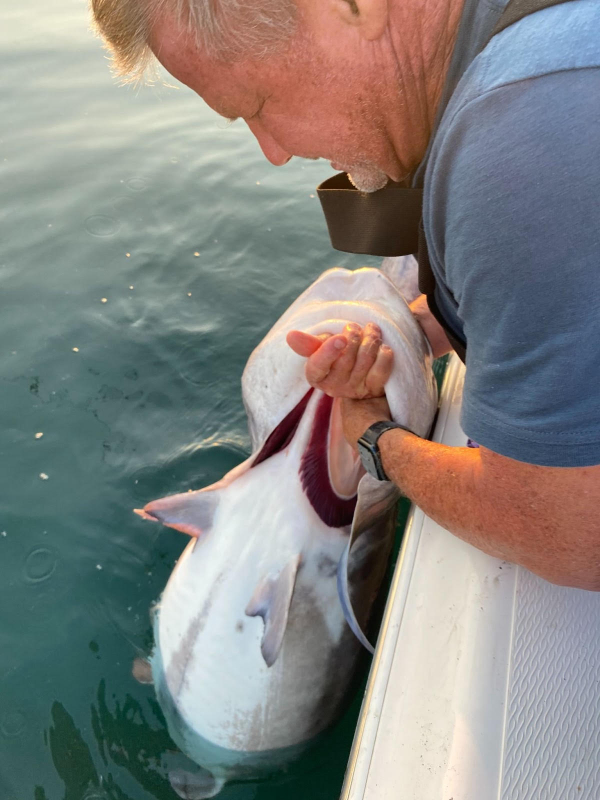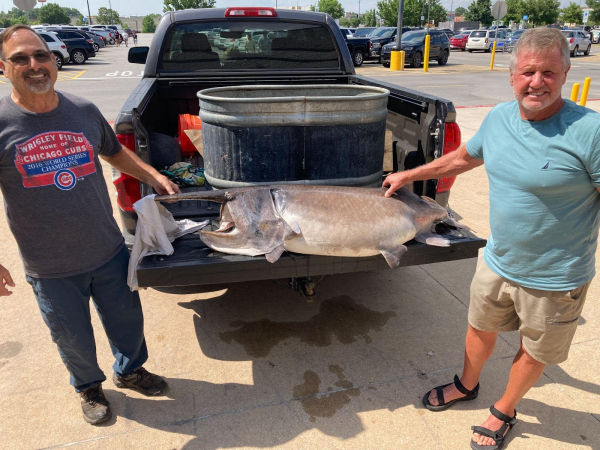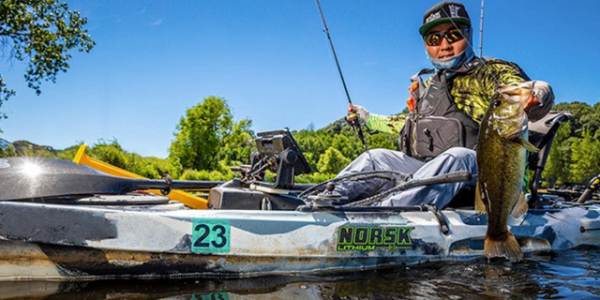Angler Snags State Paddlefish Record

Beaver Lake in Northwest Arkansas has a strong reputation for clear water and excellent bass, crappie and striper fishing, but a string of state records for paddlefish is beginning to put Beaver on the big fish map in regard to another species. Garfield resident and striped bass angler Mike Schleeper inked his name in the record books Saturday morning with a 127-pound, 6-ounce behemoth, squashing the previous state record of 118 pounds, caught by James Johnson in 2020.
Schleeper was trolling brooder minnows around 30 feet deep near Point 6 with his good friend and fishing partner Tom Mayberry when the catch occurred.
“I’ve been fishing for stripers up here for about 13 years, and I’ve had the chance to catch some stripers over 30 pounds, but this was different,” Schleeper said. “It didn’t strip line and stop in surges like big stripers do, he just sort of pulled the rod down and kept going. I couldn’t turn him so we had to follow him with the trolling motor for about the first 20 minutes.”
Once Schleeper did manage to sway the fish in his direction, the fight ensued for nearly another half-hour.
“It was a 45-minute fight altogether,” Schleeper said. “I’d thought maybe it was a really big striper, but then we could finally see it a little bit. It looked like a giant catfish at first, but as we got it closer to the boat we realized what it was.”
The giant paddlefish had been hooked in one of its pectoral fins incidentally while the anglers were trolling. Snagged fish often don’t count toward state records in many states, but paddlefish are accepted because these fish do not bite lures and catches on rod-and-reel are almost exclusively the result of snags.
When Schleeper and Mayberry finally got the fish to the side of the boat, they ran into a snag of their own.
“Our net wasn’t big enough for the fish,” Schleeper said. “Tom wrestled with that fish for a while trying to figure out a way to get it in the boat. At one point I told him to just cut the line because it wasn’t worth it. Tom was adamant that we needed to get that fish in and report it.”
Schleeper agreed with Mayberry and they finally worked a rope through the fish’s mouth to hoist it aboard.
“As soon as the fish fell to the bottom of the boat, the hook popped free,” Schleeper said. “We got really lucky.”
According to Jon Stein, Arkansas Game and Fish Commission fisheries supervisor for Northwest Arkansas, Schleeper’s fish is the latest in a series of paddlefish cresting the century mark during the last few years in Beaver Lake. They are the product of a series of stockings that took place from 1990-2000 to ensure a source of broodstock in case local river fisheries began seeing declines.
“Thankfully, paddlefish continue to do well in other rivers, and the Beaver Lake fish were never needed,” Stein said. “However, these fish are producing great trophy potential for anglers.”
Paddlefish are the oldest surviving animal species in North America according to fossil records. In fact, paddlefish predate some dinosaurs (300 million years). Females may spawn only once every 4 to 7 years.
Paddlefish are planktivores that feed by swimming with their mouths wide open and straining out microscopic plants and animals (phytoplankton and zooplankton) with special gill rakers. They rarely, if ever, bite a baited hook, so catches of these fish are often either the result of spearfishing, intentional snagging during special seasons, incidental snagging by anglers fishing for other species, and nets used by commercial anglers.
The eggs of paddlefish can be used to create caviar. Although it is not as highly sought after as caviar from sturgeon, paddlefish caviar has a good following and a healthy market in the United States.
A recent regulation passed by the AGFC will allow a limited, permit-based snagging season for paddlefish in the White River portion of Beaver Lake from the Twin Bridges Access to the Lake Sequoyah Dam April 15-June 15 to target some of these giant paddlefish as they move upstream.






